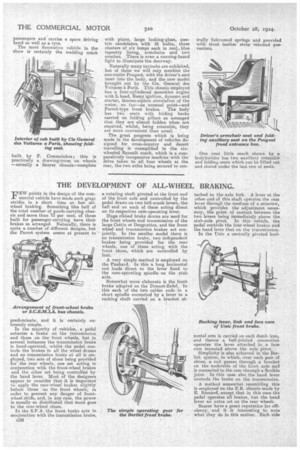THE DEVELOPMENT OF ALL-WHEEL BRAKING.
Page 20

Page 21

If you've noticed an error in this article please click here to report it so we can fix it.
EW points in the design of the com
mercial vehicle have made such great strides in a short time as has allwheel braking. Something like half of the total number of goods-carrying chassis and more than 75 per cent. of those built for passenger-carrying have their brakes so arranged. Naturally, there is quite a number of different designs, but the Perrot system seems at present to
predominate, and it is certainly extremely simple.
In use majority of vehicles, a pedal actuates a brake on the transmission and those on the front wheels, but in several instances the transmission brake is hand-operated, whilst the pedal controls the brakes in all the wheel drums and no transmission brake at all is employed, two sets of shoes being provided for the rear wheels, one set acting in conjunction with the front-wheel brakes and the other set being controlled by the hand lever. Most of the designers appear to consider that it is important to apply the rear-wheel brakes slightly before those on the front wheels, in order to prevent any danger of frontwheel skids, and, in any case, the power is usually so distributed that more goes to the rear-wheel shoes.
In the S.P.A. the front brake acts in conjunction with the transmission brake, c36 a rotating shaft pivoted at the front end of the front axle and controlled by the pedal draws on two bell-crank levers, the ball end on each of these acting direct on its respective cam-operating lever.
Huge ribbed brake drums are used for the front wheels and transmission of the large Cottin et Desgouttes, and the front wheel and transmission brakes act conjointly. In the smaller model there is no transmission brake, two independent brakes being provided for the rear wheels, one of these acting with the front shoes, which are controlled by foot.
A very simple method is employed on the Panhard. In this a long horizontal rod leads direct to the lever fixed to the cam-operating spindle on the stub axle.
Somewhat more elaborate is the front brake adopted on the Donnet-Zedel. In this each of the two cables ends in a short spindle connected by a lever to a rocking shaft carried on a bracket at tached to the axle fork. A lever at the other end of this shaft operates the cam lever through the medium of a setscrew, which provides the adjustment necessary, the point of contact between the two levers being immediately above the stub-axle pivot. In this vehicle, the pedal controls the four-wheel brakes and the hand lever that on the transmission. In the Unic a centrally pivoted hori write' arm is carried on each dumb iron, and thence a ball-jointed connection operates the lever attached to a face cam mounted above the axle pivot.
Simplicity is also achieved in the Berliet system, in which, over each pair of shoes, a rod passes through a bracket on the underside of the front axle and is connected to the cam through a flexible joint. In this case also the hand lever controls the brake on the transmission.
A method somewhat resembling this is employed on the E.B. chassis made by E. Bernard, except that in this case the pedal operates all brakes, but the hand lever an extra set on the rear wheels.
Saurer have a great reputation for efficiency, and it is interesting to note what they do in this matter. Each side
of the axle has a long bracket, through which passes a rod, the movement then being conveyed through the stub-axle pinThe front and rear brakes are pedal-operated, a separate rear brake being controlled by the hand lever. A horizontal rocking lever is mounted under each dumb iron on the Unic, and from each of these a ball-jointed link passes to the lever operating a face cam • situated above the axle pin. This cam lifts the shoe-expander lever through the medium of an adjusting set screw.
The space at our disposal has not permitted us to deal-so thoroughly as we would have wished with the general theory of front brake design as we have had to confine ourselves to what was actually to be seen, but the subject has already been treated in extemsa in previous issues of The Commercial Motor, to which we refer those a our readers who wish to pursue the subject to a greater depth.




































